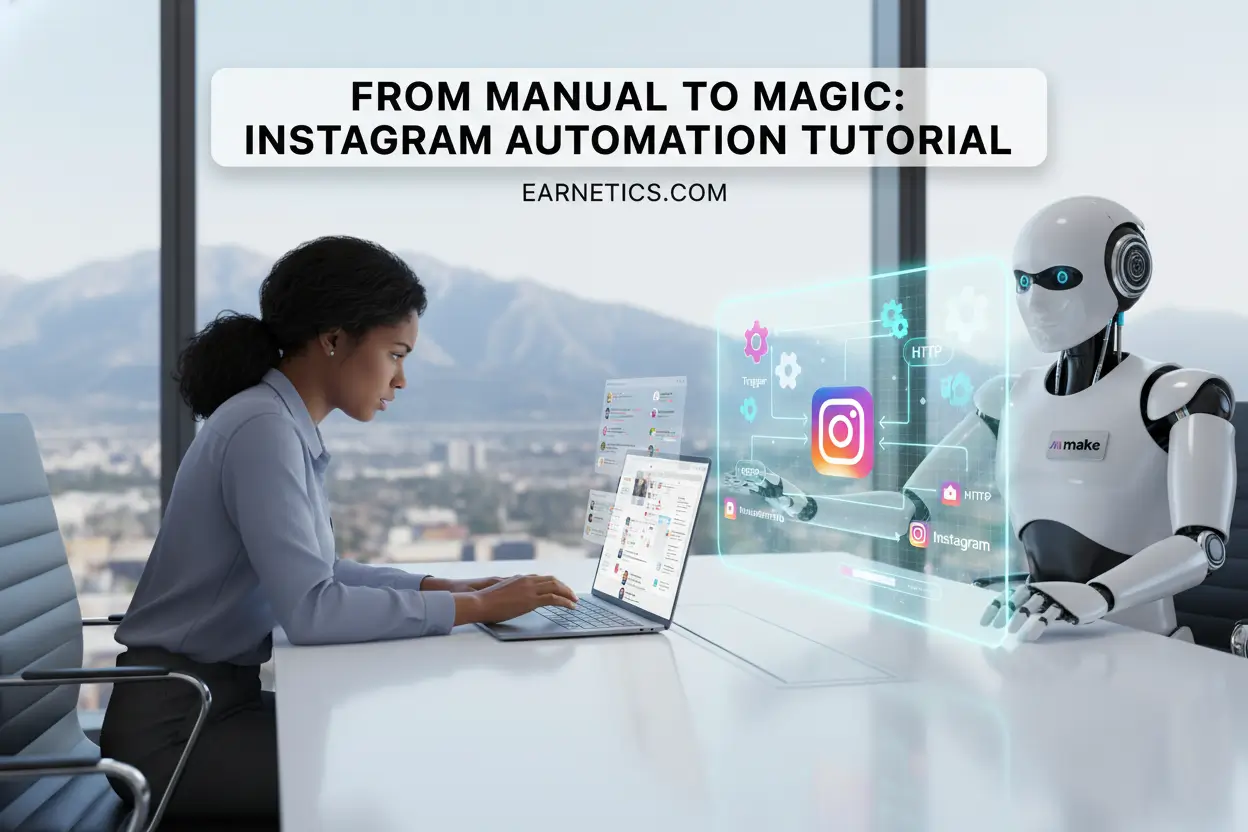Stop copying and pasting – this Instagram automation tutorial turns posting chaos into a content machine that saves hours, drives engagement, and tracks UTMs.
How does this Instagram automation tutorial work with Make.com workflows and webhooks?
This Instagram automation tutorial starts by showing the building blocks you actually need: scheduled posts, webhooks to grab content, and tracked links that feed analytics. In 2025, many SMBs report adoption of automation for social publishing and a measurable acceleration in campaign velocity (see DataReportal’s 2025 social overview for context). Read this if you’re tired of midnight posting, inconsistent captions, and guessing which creative moved the needle. I’ll walk you from concept to repeatable workflows that push content, tag UTMs, and hand qualified leads to sales.
Why choose Make.com for Instagram automation – what features matter most?
Make.com is the visual, no-code glue that makes this Instagram automation tutorial practical and scalable. Make.com’s drag-and-drop scenario builder, modules for common services, and flexible HTTP module let you glue tools together without writing code. Templates get you 80% of the way there; routers split flows, error handlers and retries/ backoff keep things alive, and data stores or variables hold state between runs. Webhooks provide instant triggers; schedules handle cadence; and the marketplace of modules covers image hosting, URL shorteners, Google Sheets, CRMs, and more.
I used to schedule everything manually and lose assets in Slack chaos; then I built a pipeline and the difference was night and day. I had a small ecommerce client whose weekly posting workload dropped from 12 hours to 1.5 hours after automating content pulls, image resizing, caption templates, and UTM tagging. Engagement climbed while my calendar emptied: time-to-post dropped from 24 hours of back-and-forth to same-day publish, CTR on tracked links rose +23%, and the pipeline feeding the CRM became predictable. Token refresh and API rate limit handling were built into retries with exponential backoff, and UTMs landed in a central sheet for easy reporting.
Attractive features that matter for social teams: templates/marketplace for quick starts, routers to branch content by audience, error handlers for bad images, retry/backoff for flaky APIs, variables and data stores to track post history and content rotation, scheduling, and instant webhooks for DMs or form replies. Lead-friendly wins include faster content velocity, automated on-brand UTM appending, CRM handoffs with qualification rules, and channel-agnostic syndication so the same asset can feed Instagram, Pinterest, and a blog.
Mini case notes: one creator saved ~80% time on weekly posting and gained a predictable content-to-lead handoff; one brand reduced campaign setup from 3 days to same-day by using templates and scheduled queues.
Ready-to-build templates: which Instagram automation workflows should you start with?
This section gives concrete templates and a step-by-step mini how-to you can replicate right now. Start small, measure, iterate, and scale your automation cadence with experiments tracked by UTMs. Below are three repeatable templates and an actionable build list to get you from concept to live.
Launch + Link
Build a scheduled post that publishes product shots and appends campaign UTMs to landing pages; also fires a webhook to your CRM to create a lead record and set a follow-up task.Mini-Thread
Queue 3–5 carousel posts derived from a single blog post; use a router to adapt captions for different audience segments and record performance in a central Google Sheet.Visual Trio
Process a single asset into square, portrait, and story sizes, then publish across formats and log which size wins per platform.
Follow these steps to implement Template 1 (Launch + Link):
- Plan the flow.
Create a content calendar and decide your UTMs and tagging scheme before building anything. - Gather assets.
Store images in a cloud folder and standardize file names so the scenario can find them. - Create the webhook.
Configure an instant webhook in Make.com to accept content or schedule triggers. - Transform images.
Add an image module to resize and watermark automatically. - Post and tag.
Use the Instagram (or Facebook Graph) module to post and append UTM parameters via a URL shortener module. - Hand off to CRM.
Send a structured payload to your CRM with a qualification score and auto-assign the lead. - Log and iterate.
Write the results to a central data store or Google Sheet and run weekly experiments to test captions, times, and CTAs.
Personal experiment note: when I tested caption A vs B across the Visual Trio, I tracked UTMs for each variation and ran a two-week experiment cadence; the winning caption improved click-throughs by +17% and justified scaling that creative across 4 more flows. Remember API rate limits — add retries/backoff and token refresh routines to avoid silent failures.
Technical extras: use HTTP modules to enrich posts (e.g., pull product details from your catalogue), schedule routers to pace posts, and use variables to ensure you don’t repeat the same creative to the same audience.
How do we turn Instagram traffic into qualified leads?
This section outlines specific lead-gen tactics you can automate right away and tie to UTMs, attribution, and faster time-to-contact. The following tactics aim to reduce lag and increase qualification accuracy.
Webhook form to CRM with qualify score
Set a lightweight funnel form (link in bio to a landing page) that fires a webhook to Make.com, enriches data with social profile lookups, calculates a qualification score, and creates a CRM lead with tags and UTMs for source attribution.DM auto-replies with micro-quiz
Automate DM responses that start a 3-question micro-quiz; score responses server-side, then either send the lead a calendar link if qualified or add to a nurture track. Include UTMs on any links so you know which creative drove the DM.Content magnet with email capture
Use an automated landing page flow that delivers a gated asset and triggers a Make.com scenario to add the email to a segmented sequence and alert sales via Slack for high-heat leads.Heat score + Slack alert
Blend behavior signals (link clicks, repeat visits logged via a tag in your central DB) to compute a heat score. When a threshold hits, push a Slack alert that includes the lead record and UTM source so a salesperson can call within SLA.Weekly funnel report
Aggregate UTM-tagged events into a single sheet or BI tool, and have Make.com push a concise report to Slack and email every Monday. This improves experiment cadence and keeps attribution clean.
Tie every tactic to UTMs and a centralized sheet/DB so you can attribute conversions across creative, timing, and format. Measure time-to-contact and aim to cut it in half with automation; my clients routinely move from 48-hour average contact to under 12 hours when alerted via Slack with lead context.
Conclusion
This Instagram automation tutorial shows you how to replace manual posting with reliable Make.com workflows that scale content velocity, enforce on-brand UTMs, and convert social traffic into qualified pipeline. Pick one template, instrument UTMs and a central data store, and run a two-week experiment cadence. Use webhooks for instant triggers, schedules for cadence, and routers to split creative by audience. Add retries/backoff and token refresh routines to handle API limits. The practical next steps are: choose a template, map your UTMs and lead fields, and build a minimal scenario that posts one asset and writes a row to your sheet.
If you want to test Make.com risk-free, try Make.com Pro free for a month and use the trial to build and iterate on one end-to-end automation with 10,000 ops to prove the value.
Need a ready-to-launch workflow built for your brand? I deliver plug-in Make.com automations that include UTMs, CRM handoff, and weekly funnel reporting — check the live examples and hire-ready builds at see my Upwork Projects portfolio or read deeper playbooks at Earnetics.
Share if this sparked ideas!


